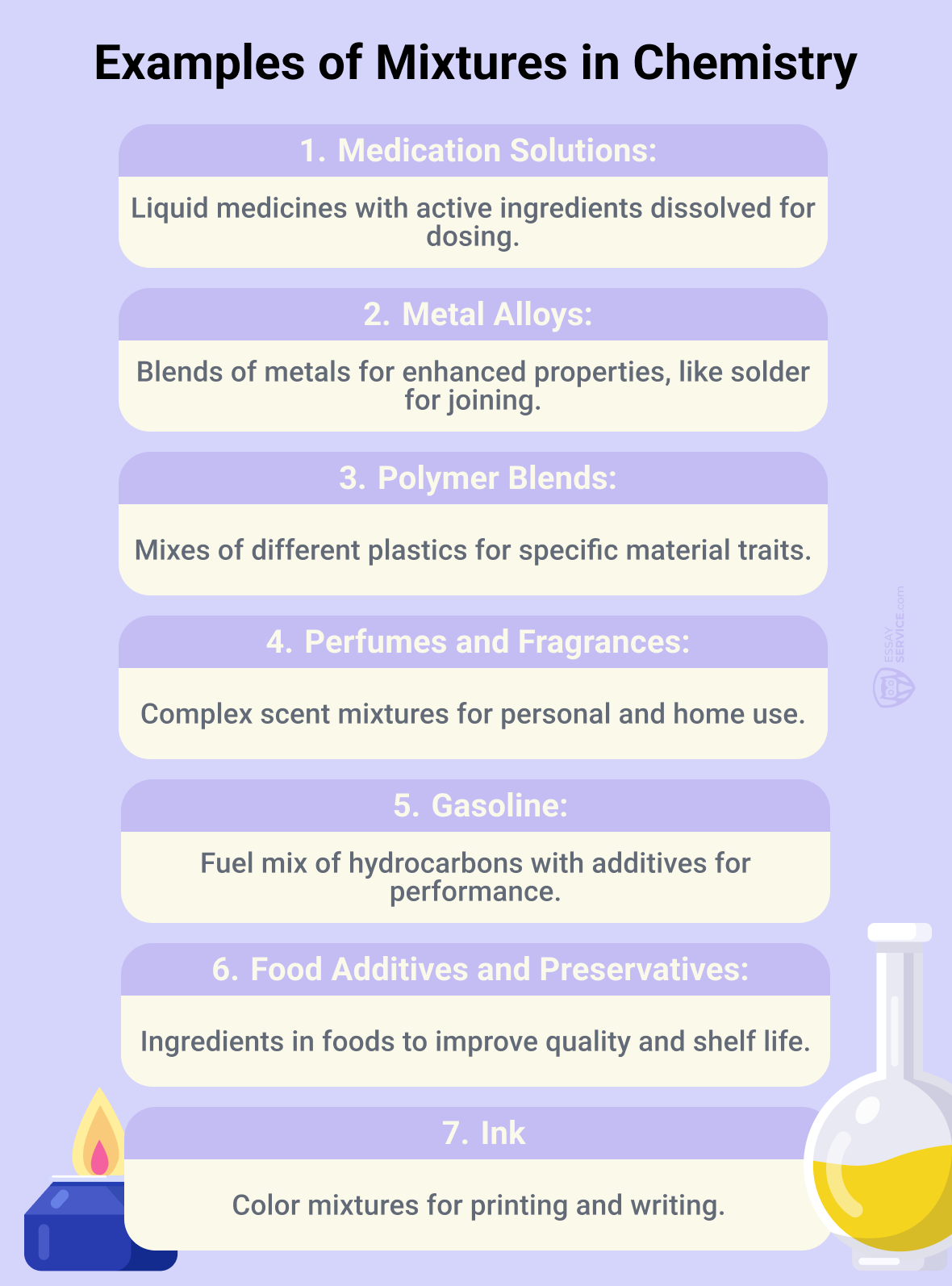
Examples of Mixtures in Chemistry: Definition, Properties, and Examples
Mixtures are everywhere in the world of chemistry, from the stuff in your kitchen cabinet to the air we breathe. They're like blends of different ingredients that hang out together without getting too cozy. But these mixtures aren't just mundane; they're crucial for understanding how chemicals work and for making all sorts of useful stuff, like medicines and materials. In this article, we're going to check out some everyday examples of such chemical components as mixtures in chemistry, see what they're made of, and why they matter in science and everyday life.
What Is a Mixture?
In chemistry, a mixture combines two or more physically intermingled substances but not chemically bonded. Unlike compounds, which are formed through chemical reactions and have fixed frameworks, mixtures retain the attributes of their constituent parts. A mixture can vary widely in arrangement and can be classified based on their particles' size and their distribution uniformity. Homogeneous mixtures, such as solutions, have uniform formulas throughout and are difficult to distinguish visually. In contrast, heterogeneous mixtures, like suspensions or colloids, have visible differences in composition and can be separated through physical means.
Mixtures play a crucial role in numerous natural and synthetic processes, influencing everything from the food we eat to the materials we use. They enable the creation of alloys and blends of metals with enhanced characteristics, being integral to processes like filtration and distillation used in purification. Moreover, a mixture is central to fields like environmental science, where understanding the structure of air and water mixtures is essential for monitoring pollution levels.
What Are the Properties of Mixtures?
A mixture is a combination of two or more substances that are physically combined, but not chemically bonded. Here are some key features of mixtures:
- Composition
Mixtures can vary in composition. They can be homogeneous, where the elements are evenly distributed and not visually distinguishable (like salt dissolved in liquid), or they can be heterogeneous, where the constituents are not evenly distributed and can be visually distinguished (like a salad with different vegetables).
- Separation
Components of a mixture can usually be separated using physical means. For example, filtration can be used to separate solid particles from a liquid, distillation can be used to separate liquids with different boiling points, and chromatography can be used to separate ingredients based on their affinity for a stationary phase.
- Physical Idiosyncrasies
The physical traits of a mixture are usually a combination of the quirks of its individual components. For example, the boiling point of a mixture of ethanol and water will be between the boiling points of pure ethanol and pure liquid.
- No Fixed Ratio
Unlike compounds, mixtures do not have a fixed ratio of elements. The ratio of components in a mixture can vary over a wide range.
- No Chemical Reaction
The components of a mixture retain their individual chemical attributes and do not undergo a chemical reaction to form new substances.
- Variable Properties
The properties of a mixture can vary depending on the proportions of its parts. For example, the color of a mixture of red and blue pigments will depend on the relative amounts of each pigment.

Characteristics of Mixtures
Mixtures exhibit several characteristics that distinguish them from pure substances and compounds. Here are some key characteristics of mixtures:
- Phase Separation
Mixtures can exist in different phases (solid, liquid, gas) depending on the characteristics of their integrals. For example, a mixture of ice cubes (solid) and liquids is a heterogeneous mixture with two distinct phases.
- Combinability
Mixtures allow for the combination of substances in various proportions to achieve desired properties or characteristics. This flexibility is particularly useful in industries like food processing, where recipes often involve mixing different ingredients to create specific flavors and textures.
- Variable Properties Across Space
In heterogeneous mixtures, the attributes can vary across different regions of the mixture. For instance, in a heterogeneous mixture of soil and liquid, the concentration of soil particles may vary at different depths or locations within the mixture.
- Continuity
Mixtures lack a sharp boundary between their components, unlike compounds which have distinct chemical structures. Instead, mixtures exhibit continuity between the substances involved, allowing for gradual transitions in features.
- Dependence on Mixing Method
The idiosyncrasies of a mixture can be influenced by physical methods used to combine its elements. For example, mixing by stirring may result in a different distribution of particles compared to mixing by shaking.
- Mechanical Stability
Mixtures can possess mechanical stability, meaning they maintain their struture and qualities under certain conditions. However, some mixtures may separate or undergo phase changes when subjected to external factors such as temperature, pressure, or agitation.
- Limited Homogeneity
While homogeneous mixtures have uniform constitutions, they may still exhibit slight variations in peculiarities due to factors like temperature gradients or differences in molecular interactions between constituent parts.
- Natural Occurrence
Mixtures are ubiquitous in nature and can be found in various forms, from the air we breathe (a mixture of gases) to the soil beneath our feet (a mixture of minerals, organic matter, and fluid).
Examples of Mixtures in Chemistry
Let's explore the two main types of mixtures commonly encountered in chemistry:

Heterogeneous Mixture
Heterogeneous mixtures are those in which the components are not uniformly distributed throughout the mixture. This means that the mixture contains visibly distinct phases or regions with different configurations. Examples of heterogeneous mixtures include a salad with various vegetables, a mixture of oil and fluid, or a mixture of sand and iron filings. In these examples, you can visually distinguish the individual parts within the mixture. Due to the non-uniform distribution of facets, the traits of heterogeneous mixtures can vary from one region to another.
Homogeneous Mixture
On the other hand, homogeneous mixtures are those in which the elements are uniformly distributed throughout the mixture, resulting in a single phase with uniform attributes. In other words, the mixture appears visually the same in all parts. Examples of homogeneous mixtures include salt dissolved in water, sugar dissolved in tea, or air (a mixture of gases). In these examples, the homogeneous elements are evenly dispersed at the molecular level, leading to a uniform appearance and consistent qualities throughout the mixture.
Examples of Mixtures in Our Everyday Life
Mixtures are all around us in our everyday lives, playing crucial roles in various activities and processes. Here are some examples:
- Air
The air we breathe is a mixture of gases, primarily nitrogen (~78%), oxygen (~21%), carbon dioxide, and trace amounts of other gases. This mixture is essential for sustaining life and is involved in processes like respiration, combustion, and weather phenomena.
- Vinegar
Vinegar is a homogeneous mixture composed of acetic acid and fluid. When vinegar is produced through fermentation, acetic acid molecules dissolve uniformly, resulting in a homogeneous sap with a sour taste and distinctive aroma. Vinegar is commonly used in cooking, cleaning, and food preservation.
- Salad
A salad is a heterogeneous mixture composed of various ingredients such as lettuce, tomatoes, cucumbers, carrots, and dressing. Each of them retains its individual features, contributing to the flavor, texture, and nutritional content of the salad.
- Coffee
Coffee is a homogeneous mixture of fluid, coffee beans (which contain soluble compounds like caffeine and flavor compounds), and other additives like sugar, milk, or cream. When properly mixed, they create a uniform beverage with a distinct taste and aroma.
- Seawater
Seawater is a complex mixture of water, salts (such as sodium chloride), dissolved gases (like oxygen and carbon dioxide), and suspended particles (such as plankton and sediment). This mixture supports diverse marine life and plays a crucial role in Earth's climate and hydrological cycles.
- Soil
Soil is a heterogeneous mixture of mineral particles (like sand, silt, and clay), organic matter (such as decaying plant and animal materials), liquid, air, and microorganisms. This mixture provides nutrients and support for plant growth and is essential for agriculture and ecosystem functioning.
- Trail Mix
Trail mix is a heterogeneous mixture consisting of various ingredients such as nuts, seeds, dried fruits, chocolate chips, and sometimes pretzels or crackers. It provides a convenient and nutritious snack for activities like hiking and camping.
- Alloys
Alloys are homogeneous mixtures of two or more metals, or a metal and a non-metal. Common examples include brass (a mixture of copper and zinc), bronze (a mixture of copper and tin), and stainless steel (a mixture of iron, chromium, and nickel).
- Tap Water
Tap water is a mixture of fluid and dissolved minerals, gases, and trace contaminants. Depending on the source and treatment processes, the composition of tap water can vary, but it generally contains ions like calcium, magnesium, and bicarbonate.
- Concrete
Concrete is one of the heterogeneous mixtures consisting of cement, aggregates (such as sand and gravel), water, and additives. This mixture forms a durable and versatile construction material used in buildings, roads, bridges, and other infrastructure projects.
As you can see, mixtures are an interesting topic that has a tight relation to a world around us. If you need chemistry homework help to better understand the interplay of different substances that we breathe, eat, or interact with, feel free to consult our experts!
Frequently asked questions
New posts to your inbox!
Your submission has been received!



